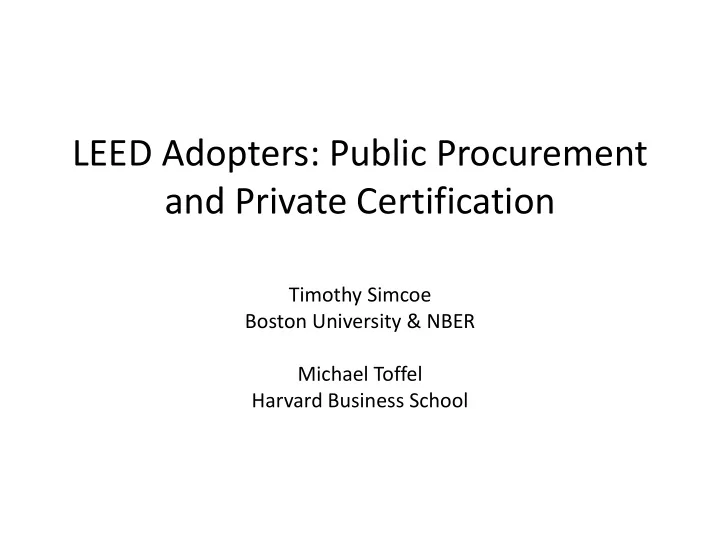

LEED Adopters: Public Procurement and Private Certification Timothy Simcoe Boston University & NBER Michael Toffel Harvard Business School
Procurement Spillovers • Procurement as public policy tool – EPA Environmentally Preferable Purchasing – EU Green Public Procurement • Will these polices have a large impact? – Direct effect is necessarily limited • Gov’t = max 10-15% of all purchasing (Marron 2003) – Net impact hinges on private-sector spillovers • Research Question: Do municipal green-building procurement policies induce private green building?
Paper Overview • Empirical case study of LEED certification – Treatment = Municipal Green Building Policy – Matching and difference-in-differences methods • When CA cities commit to green procurement: – Private-sector LEED registrations increase • From ~7% to ~13% of all new non-residential construction – LEED Professional Accreditations (APs) increase – Similar effects in adjacent neighbor cities – No evidence of pre-policy impacts
What’s going on? Municipal Government Local Tastes & Demand Accredited Real Estate Professionals Developers • Unobserved local preference for green construction • Municipal government as “LEED” adopter – Demand effects (e.g. Corts 2010) => Increase in LEED APs – Regulatory coercion => Developers adopt LEED – Government as catalyst (e.g. Farrell and Saloner 1986)
Green Building Certification: Overview • Leadership in Energy & Environmental Design (LEED) – US Green Building Council (1998) – Point system: Certified, Silver, Gold, Platinum – Tailored to New Construction , Existing Buildings, Retail… • Benefits of LEED – Higher rents and occupancy rates (Eichholtz, Kok & Quigley 2009) – Energy savings of ~25%? (Turner and Frankel 2008) • Basic Certification Process – Register with USGBC / GBCI ($450-600) – Design and Build • Huge variation in $/point • Key input: LEED Accredited Professionals ($350 exam) – Third-party certification (~$2000)
Annual LEED Registrations Federal, State & Local gov’t are a declining share of annual LEED registrations
Municipal Green Building Policies • Hand collected data on public procurement (early 2009) – Start with USGBC and DSIRE lists – Found 144 US cities, 40 in California – Read municipal codes • Conservative definition of “green procurement” – No observable incentives for private developers – Ninety percent of municipal policies use LEED points • Substantial heterogeneity across cities – Who is affected? • Size, owner, use, new vs. renovations – Design: Tax credits, zoning, procurement, fee-bates – Measurement: What is green?
Empirical Methods • Threats to causal inference – OVB: Green tastes => policy & registration – Reverse Causation: Private LEED => policy change • Empirical strategy – 1) Coarsened Exact Matching (Iacus, King & Porro 2009) • Requires some city- level “green” observables • CA ballots, LCV scores & Prius registrations (Kahn 2002, 2009) – 2) Analyze adopters and adjacent neighbors – 3) Timing: Diff-in-diffs and hazard of policy adoption
CEM Intuition & Advantages Coarsen => Stratify => Exact Match => Weighted OLS Green Brown 10 Treated 5 Treated Large 10 Control 10 Control CEM Weight = 1 CEM Weight = ½ 5 Treated 1 Treated Small 10 Control 100 Control CEM Weight = ½ CEM Weight = 0.01 Transparent, non-parametric, matches all moments We match on Prius, Population, New buildings and Income
Matching and Balance Tests
Main Results: Cross-section Adopters and Neighbors and Matched Controls Matched Controls Outcome Registrations Accreditations Registrations Accreditations Green Policy 6.63 11.55 (3.20)** (13.79) Green Neighbor 0.77 4.06 (0.38)** (1.32)*** Prius 2008 -6.39 -17.80 0.20 1.31 (4.23) (21.26) (0.42) (1.55) Green Ballot Share 20.78 23.00 0.47 -6.62 (12.09)* (48.43) (1.06) (3.91)* Observations 202 202 453 453 R-squared 0.55 0.36 0.15 0.34 Mean DV 7.92 39.74 1.11 5.24 Marginal Effect 84% 29% 69% 77%
Diff-in-Diffs: Adopter Registrations Y it = α i + λ t + β y GreenPolicy i + ε it Average difference in LEED registration rate between adopter and control cities 2 years after policy adoption (relative to pre-adoption year)
Diff-in-diff: Neighbor-city LEED APs Average difference in number of new LEED APs between neighbor and control cities 2 years after policy adoption (relative to pre-adoption year)
Potential Extensions • Would like to estimate the “structural” parameters – Need instruments for accreditation and/or certification • Fine-grained analysis of LEED Accredited Professionals – Data on all CA licensed architects – Address data for buildings and architects Instrumental Variable Accredited Real Estate Professionals Developers
Conclusions & Caveats • Evidence of green procurement spillovers • Potential mechanisms – Gov’t as lead adopter => Stimulates supply of APs – Gov’t as catalyst => Coordinates developers & APs • Caveats – Extrapolation & stacking the deck – Environmental impact? – Procurement policy lock-in • Might other standards (e.g. Energy Star) be better?
Thank You! tsimcoe@bu.edu mtoffel@hbs.edu
Hazard Models for Policy Adoption Evidence against “capture” & reverse causality
LEED Threshold Effects
Recommend
More recommend